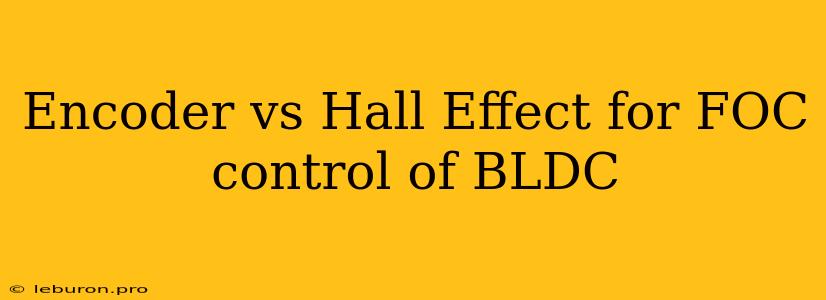The choice between encoder and Hall effect sensors for Field-Oriented Control (FOC) of brushless DC (BLDC) motors hinges on several factors, including accuracy, cost, complexity, and application requirements. Both encoder and Hall effect sensors play a crucial role in providing feedback to the motor controller, enabling precise control of the motor's speed, torque, and position. Understanding the strengths and weaknesses of each sensor type is essential for making an informed decision in motor control applications.
Encoder vs Hall Effect Sensors: Navigating the Terrain of BLDC Motor Control
Encoder and Hall effect sensors are the two most common types of sensors used in BLDC motor control systems for providing rotor position feedback. While both sensors serve the same purpose, they operate on different principles and possess distinct advantages and disadvantages. This article delves into the key differences between encoder and Hall effect sensors, exploring their respective strengths and weaknesses in the context of FOC control for BLDC motors.
Encoder Sensors: Precision and Versatility
Encoder sensors are electromechanical devices that convert the angular position of a rotating shaft into electrical signals. They typically consist of a rotating disc with a pattern of alternating light and dark segments, or magnetic poles, and a stationary sensor unit that detects the pattern. As the shaft rotates, the sensor unit detects the changes in the pattern, generating a digital signal that corresponds to the shaft's position.
Types of Encoders:
There are two main types of encoders:
- Incremental Encoders: These encoders generate a series of pulses for each rotation of the shaft, providing information about the change in position.
- Absolute Encoders: These encoders provide a unique digital code for each position of the shaft, allowing for precise position determination regardless of the starting position.
Advantages of Encoder Sensors:
- High Resolution: Encoders, particularly absolute encoders, offer high resolution, providing detailed information about the shaft's position. This high resolution translates into smoother and more precise motor control.
- Wide Operating Range: Encoders can operate over a wide range of speeds and temperatures, making them suitable for various applications.
- Robustness: Encoders are generally robust and can withstand harsh environments.
Disadvantages of Encoder Sensors:
- Cost: Encoders, particularly absolute encoders, can be relatively expensive compared to Hall effect sensors.
- Complexity: Encoder systems can be more complex to install and integrate compared to Hall effect sensors.
- Sensitivity to Noise: Encoders can be susceptible to noise and interference, which can affect their accuracy.
Hall Effect Sensors: Simplicity and Affordability
Hall effect sensors are solid-state devices that detect the presence of a magnetic field. In a BLDC motor, Hall effect sensors are typically placed near the rotor magnets, and the sensor output changes as the rotor magnets pass by. This change in output is used by the motor controller to determine the rotor position.
Advantages of Hall Effect Sensors:
- Low Cost: Hall effect sensors are generally less expensive than encoder sensors.
- Simplicity: Hall effect sensors are simple to install and integrate into a motor control system.
- Reliability: Hall effect sensors are known for their reliability and durability.
Disadvantages of Hall Effect Sensors:
- Limited Resolution: Hall effect sensors offer a limited resolution compared to encoders, which can affect the precision of motor control.
- Speed Limitations: Hall effect sensors can be limited in their ability to accurately measure the position at very high speeds.
- Temperature Sensitivity: Hall effect sensors can be sensitive to temperature changes, which can affect their performance.
Selecting the Right Sensor for Your BLDC Motor
The choice between encoder and Hall effect sensors for FOC control of BLDC motors depends largely on the specific application requirements. Here's a breakdown of factors to consider:
- Cost: If cost is a primary concern, Hall effect sensors are the more affordable option.
- Accuracy: If high accuracy is required, encoders, particularly absolute encoders, are the preferred choice.
- Speed: For high-speed applications, encoders are better suited due to their ability to provide accurate position information at higher speeds.
- Environment: Encoders are generally more robust and can withstand harsh environments.
Conclusion: Making the Right Choice for Your Application
Both encoder and Hall effect sensors offer valuable feedback mechanisms for FOC control of BLDC motors. While encoders provide higher resolution and accuracy, they come at a higher cost and complexity. Hall effect sensors, on the other hand, are simpler and more affordable, but they offer limited resolution. Ultimately, the best sensor type for a particular application depends on factors such as cost, accuracy, speed, and environmental conditions. By carefully evaluating these factors, designers can select the most suitable sensor for achieving optimal performance in BLDC motor control systems.
